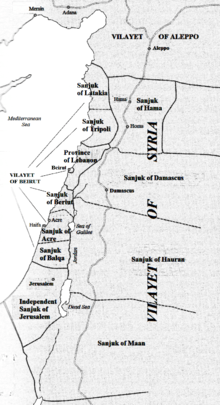Beirut Vilayet
The Vilayet of Beirut was a first-level administrative division (vilayet) of the Ottoman Empire. It was established from the coastal areas of the Syria Vilayet in 1888 as a recognition of the new-found importance of its then-booming capital, Beirut, which had experienced remarkable growth in the previous years — by 1907, Beirut handled 11 percent of the Ottoman Empire's international trade.[2] It stretched from just north of Jaffa to the port city of Latakia.[3] It was bounded by the Syria Vilayet to the east, the Aleppo Vilayet to the north, the autonomous Mutasarrifate of Jerusalem to the south and the Mediterranean Sea to the west.
| Beirut Vilayeti | |||||||||
|---|---|---|---|---|---|---|---|---|---|
| Vilayet of the Ottoman Empire | |||||||||
| 1888–1917 | |||||||||
.png) The Beirut Vilayet in 1900 | |||||||||
| Capital | Beirut | ||||||||
| Area | |||||||||
• 1885[1] | 30,490 km2 (11,770 sq mi) | ||||||||
| Population | |||||||||
• 1885[1] | 533,500 | ||||||||
| History | |||||||||
• Established | 1888 | ||||||||
• Disestablished | 1917 | ||||||||
| |||||||||
| Today part of | |||||||||
At the beginning of the 20th century, it reportedly had an area of 11,773 square miles (30,490 km2), while the preliminary results of the first Ottoman census of 1885 (published in 1908) gave the population as 533,500.[1] It was the 4th most heavily populated region of the Ottoman Empire's 36 provinces.[4]
Administrative divisions
Sanjaks of the vilayet:[5]
- Latakia Sanjak
- Tripoli Sanjak
- Beirut Sanjak
- Akka Sanjak
- Nablus Sanjak
 Map of Ottoman Levant
Map of Ottoman Levant.jpg) 1893 map of administrative divisions of Ottoman Asia
1893 map of administrative divisions of Ottoman Asia
References
- Asia by A. H. Keane, page 460. Note: The accuracy of the population figures ranges from "approximate" to "merely conjectural", depending on the region from which they were gathered.
- Encyclopedia of the Ottoman Empire, p. 87, at Google Books By Gábor Ágoston, Bruce Alan Masters
- Bruce Masters (2013-04-29). The Arabs of the Ottoman Empire, 1516-1918: A Social and Cultural History. Cambridge University Press. p. 182. ISBN 978-1-107-03363-4. Retrieved 2013-06-08.
- Karpat, Kemal H. (1985). Ottoman Population, 1830-1914: Demographic and Social Characteristics. University of Wisconsin Press. p. 210. ISBN 978-0-299-09160-6.
Table IV.2 Population Density per km2, and Density Rank, 1894/95 (R. 1310), Rank 4, with population of 573,000 and density of 45.47 per km2; underlying source IUKTY 9075
- Beyrut Vilayeti ve Cebel-i Lübnan Mutasarrıflığı | Tarih ve Medeniyet
Chisholm, Hugh, ed. (1911). . Encyclopædia Britannica (11th ed.). Cambridge University Press.
External links
